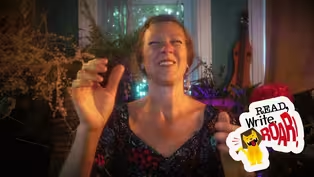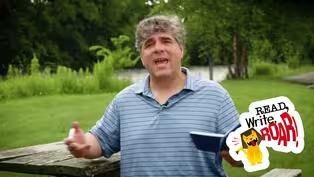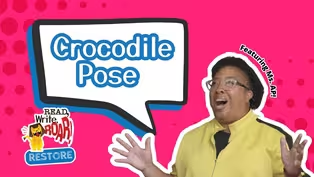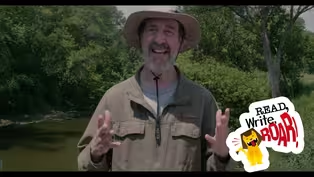Read, Write, ROAR!
A Green Michigan
Season 1 Episode 1015 | 25m 45sVideo has Closed Captions
Discover how to turn everyday moments into captivating prose by using your senses and emotions
Explore Michigan’s state tree, the White Pine, through poetry, and learn how to choose the perfect words to create vivid imagery. Then, discover how to turn everyday moments into captivating prose by using your senses and emotions to bring your writing to life. Let’s go Read, Write, ROAR!
Problems playing video? | Closed Captioning Feedback
Problems playing video? | Closed Captioning Feedback
Read, Write, ROAR! is a local public television program presented by Detroit PBS
Read, Write, ROAR!
A Green Michigan
Season 1 Episode 1015 | 25m 45sVideo has Closed Captions
Explore Michigan’s state tree, the White Pine, through poetry, and learn how to choose the perfect words to create vivid imagery. Then, discover how to turn everyday moments into captivating prose by using your senses and emotions to bring your writing to life. Let’s go Read, Write, ROAR!
Problems playing video? | Closed Captioning Feedback
How to Watch Read, Write, ROAR!
Read, Write, ROAR! is available to stream on pbs.org and the free PBS App, available on iPhone, Apple TV, Android TV, Android smartphones, Amazon Fire TV, Amazon Fire Tablet, Roku, Samsung Smart TV, and Vizio.
Providing Support for PBS.org
Learn Moreabout PBS online sponsorship- On "Read, Write, Roar."
Explore Michigan's state tree, the white pine, through poetry, and learn how to choose the perfect words to create vivid imagery.
Then discover how to turn everyday moments into captivating prose by using your senses and emotions to bring your writing to life.
Let's go read, write, roar.
- [Announcer] This program is made possible in part by the state of Michigan and by: And by viewers like you.
Thank you.
(energetic upbeat music) - Hi, scholars.
Check this tree out.
Do you know what kind it is?
This is a white pine tree, which is Michigan's state tree.
I'm Mrs.
Mask, and today we're going to work on drafting and revising a poem about the white pine.
The white pine tree can grow to more than 150 feet tall.
It has long blue green needles that grow in bundles of five.
The white pine grows in Michigan's forest, mostly in the northern lower peninsula and the upper peninsula.
Because Michigan was the largest producer of lumber in the United States from around 1870 to 1900 using mainly white pine, it was officially named Michigan's state tree on March 4th, 1955.
White pine is still used a lot for building and is a favorite choice for Christmas trees.
I use it at my house.
Before we look over and read my drafted poem about the white pine, I just wanna remind everyone that not all poems rhyme.
Sometimes it's hard to get thoughts across if we need to include rhyming, so it's nice to have options like a free verse.
A free verse is a type of poem that doesn't have to rhyme or follow any other rules.
I chose a free verse from my poem to give myself more freedom to use the information I know about the white pine and to write about it in a way that will get people who read it interested and excited without having to worry about rhyming words.
So let's take a look and follow along as I read the draft I wrote.
"The Mighty White Pine" Standing 150 feet tall A nobleman guarding a great state of Michigan So high that it touches the sky Wearing coats of snow and ice in the winter Symbols of purity and strength Roots running deep into the heart of our state Bringing us wealth and greatness And continuing to stand forever Marvels to behold as they stand guard in symmetrical lines like soldiers Providing us with handcrafted gifts Decked out in ornaments provide pleasure each Christmas What do you think of my draft?
In my poem, I really wanna describe the white pine so that it can be visualized or seen in the minds of people who read it.
I think I did a pretty good job, but I also know it's important that as writers we always consider ways to make our writing better.
Word choice is very important in writing, especially when we want to create clear images in our reader's mind.
So let's consider changing some words.
We can start by thinking of and finding synonyms for words already written in a poem.
Synonyms are words that mean the same or almost the same as another word.
I'm going to make a list of words or phrases I will plan to change while looking over my poem, along with some synonyms I might be able to use instead of what's already written in my poem.
You can make a list too, if you like.
Standing.
Hmm, soaring.
That's a good choice.
Touches the sky.
Reaches the heavens.
So touches and reaches are pretty close in meaning, and the sky is often referred to as a heaven.
So yes, reaches the heavens would be a good synonym for touches the sky.
Strength.
Resilience.
When things get tough, we need to be resilient.
Heart.
Core, I like that one.
Greatness.
Ooh, grandness.
This word makes it seem special.
Marvels, wonders.
That's a good one too.
Guard.
Sentinel.
That means the stand guard.
I had to look that one up in the dictionary to make sure I knew what it means.
Deck out, hmm.
Oh, adorn.
I use my thesaurus to find a new word.
It's a great tool that can help us find words when we get stuck.
You can use the actual book to look for synonyms or you can use an online thesaurus too.
Either way, the thesaurus helps us with word choice.
I really like the synonyms we came up with.
It's helpful to evaluate word choice in order to revise our writing.
Let's reread my poem together with the changes.
"The Mighty White Pine" Soaring 150 feet tall A nobleman guarding our great state of Michigan So high that it reaches the heavens Wearing coats of snow and ice in the winter Symbols of purity and resilience Roots running deep into the core of our state Bringing us wealth and grandness And continuing to stand forever Wonders to behold as a sentinel in symmetrical lines like soldiers Providing us with handcrafted gifts Adorned in ornaments provide pleasure each Christmas As you can see, synonyms are useful as we focus on word choice.
As writers, we're always improving our writing so we can produce the best possible version of our work.
Now give it a try with your own writing.
(energetic music) (bright music) (air whooshing) - Ms. AP here to help restore your energy.
Today we are going to be learning how to do some basic yoga poses, but before we do, let's start with our warmup.
Since we already learned how to do a squat in the last unit, let's do three squats to warm up.
1, 2, 3.
Nice job.
Now that we've warmed up our body, we are ready to exercise.
Today we are gonna start on the floor and learn our crocodile pose.
We will start in our child's pose position.
Come up to all fours, lower yourself down on the mat, push yourself up, stretch that tummy, back down to the floor, and all four, back down into your child's pose, back down to the ground.
Push yourself up.
One last time on all fours, down into that child's pose.
We're gonna walk our hands back down, push ourselves up.
Back into our all fours.
Ready position, give yourselves a big clap-clap (claps).
Nice job.
Let's cool down by taking two deep breaths.
Deep breath in (inhales).
Deep breath out (exhales).
Deep breath in (inhales).
Deep breath out (exhales).
Great job.
(air whooshing) (upbeat music) - Hi, I'm Naturalist Paul Rus.
Today we're visiting the Thomas Township Nature Center and Preserve.
We are going to explore the role of a nature preserve and why it's important for Michigan's plants and animals.
So grab a paper, something to write with, and your nature journal, and let's go exploring outdoors.
A nature preserve is an area that is protected and managed to preserve or maintain the land's plants, animals, and physical features.
The Thomas Township Nature Preserve is adjacent to the Tittabawassee River, which provides a good source of water for wildlife.
First, I'd like to introduce you to a bird the nature preserve is trying to protect.
Take a look at this bird.
We can write down some of its features.
Its size is about four feet tall.
Its shape is slender or thin, and its color is blue-gray.
It eats fish and frogs that are found in its habitat of rivers, ponds, and wetlands.
Do you know what kind of bird this is?
A great blue heron!
Follow me, I wanna show you a special place.
We have special permission to show you a place called a heron rookery.
We wanna be quiet so we do not disturb the herons that are with eggs or baby birds in their nests.
Anytime you're walking on a trail in a park or nature preserve, I wanna encourage you to stop and read the signs.
Signs convey or communicate important information about the area and what you are seeing or even safety tips.
Let's read this sign together.
"Up and to your left, you will see a nesting area of the great blue heron.
They are a very solitary bird who prefers their privacy.
This is especially true now as it is mating season for these beautiful birds.
Step down to the left for photos.
However, please try to turn around from here and do not disturb them.
We want them to stay here.
Thank you."
The great blue herons have nests away from other birds in a grouping called a colony.
They do this to protect their eggs from predators such as crows and raccoons.
Two to six eggs are laid per nesting season.
You can look up in the trees and just make out darkened oval shaped clumps in the trees.
Can you count the clumps?
There are about 30 and each clump is a big nest.
It's a nest that is four feet wide and four feet deep.
I bet some of you could even fit in it.
Here's a closer look at a great blue heron on a nest.
Let's pause and make some notes about what we've learned about the heron and the rookery.
You can even take some time to make a drawing of the nests in the trees.
Find out more what you can do to protect the great blue heron and other wildlife of the great lakes by exploring a nature preserve in your area.
You and an adult in your life can also visit your public library to learn more about the Michigan activity pass.
This pass provides free or discounted access to more natural destinations throughout Michigan.
Remember, one way you can help protect nature and wildlife is by reading and following directions on signs.
Enjoy learning and exploring in the outdoors.
(energetic music) - It's often said reading can transport us from one world into another.
Maybe you're at home on the couch or you're sitting on a bus or in a waiting room at a doctor's office, and you escape into a world of aliens with spaceships shaped like giant pretzels.
Or all of a sudden you're hiding from a hipping python in the Amazon or slinking through sagebrush trying to catch a horse thief in Montana.
Did you ever wonder how writer weave such magical spells, how they levitate you off your couch and onto Aladdin's flying carpet?
Hi everyone, I'm Jeff Kass, and today we're gonna work on capturing what I like to call the feel of the day, when we write.
Our goal is to imagine we have a reader who is somewhere else, a cousin in Alabama, a friend in Hawaii, or even a stranger eating breakfast at a cafe in Mexico City, and that person is looking at your writing.
We want them to experience whatever you are experiencing.
We want them as much as possible to feel that they're right there beside you.
How will we do that?
There are two main steps.
First, we pay close attention to what our senses are experiencing.
That's why I like to carry a writing journal everywhere I go.
If I want to capture the feel of a place, I open my journal and I take notes so I can relay those details to a reader.
Today we're at Riverside Park.
Let's start with what I can see.
I can see trees, but to just say I can see trees is boring.
Let's spice it up or sugar it up would be more accurate.
Some of the leafy trees look like massive green marshmallows.
Others are skinnier and lighter tone like sticks of chewing gum.
I can also see kayakers, parents and their children dot the water in plastic kayaks dipping their paddles in and out, so they look like spiders skittering along the river.
What can I hear?
Kids laugh and scream in the playground.
An older brother chases his giggling younger sister up the slide and they almost collide with another kid on his way down.
Now I'm gonna combine the senses of taste and smell, based on what's happening in the picnic area.
Got burgers and bratwursts sizzling on the grill, mixed with laughter of adults keeping half an eye on their children.
Finally, I'll think about my sense of touch.
What does my body feel?
The air today is warm and moist, kind of like a locker room after the whole team has taken a shower.
The ground beneath my feet, soft and damp.
That's enough about what I see, smell and hear around me.
The feel any day also includes how I'm personally feeling and how my environment or what's around me affects my feelings.
That's the second step.
I'm gonna make a list of some things going on in my own head.
For example, I'm thinking about my son and his baseball team in South Dakota and about my daughter as she heads on a trip to Costa Rica.
I'm also thinking about what time I have to be home to walk my dog, and I'm also worried about climate change.
Okay, that's a lot to think about.
Time to start writing.
I'll take my notes and combine them with whatever else is bouncing around my brain to express what the day feels like for me.
"Feel of the Day, Riverside Park, Ypsilanti, Michigan."
The sky today after this morning's rain feels gray with sorrow.
Kids run through the playground laughing and shouting in several different languages.
One boy chases his giggling sister the wrong way up a slide, and they nearly collide with another giggling boy on his way down.
Past the trees, some of which look plump like dark green marshmallows and others thin and light colored like sticks of gum, kayakers scatter across the river.
Their paddles dip out of their plastic boats, so they look like spiders skittering across the water.
Parents and children laugh as they splash.
It's true.
I'm worried about my son playing baseball in South Dakota, about my daughter packing her suitcase for a trip to Costa Rica, about whether I'll have enough time to take my dog Snowcap for a walk before it rains tonight.
And speaking of rain, I also worry about whether the changing climate will bring a bunch of dangerous hurricanes this summer.
Still, listen to the laughter drifting through this moist air, as burgers and bratwursts sizzle on the park's community grill.
Tune in to the delighted squeals of children as they kick a soccer ball.
The ground beneath my feet is soft, unsteady, always slightly shifting.
I can shift too and figure out how to slow down and enjoy the moment and not stress out over things I can't control.
Now it's your turn.
Write your own feel-of-the-day prose paragraph.
Wherever you are, go outside.
Take something to write on and write with.
Observe what's happened around you, and jot down notes about what you can see, hear, smell, taste or touch.
Then write some notes about anything else you're thinking.
Next, take your notes and start writing a paragraph that describes the day, both the environment outside and how you're feeling inside.
Remember, your goal is to capture the feel of the day for someone far away, a reader you want to invite into your world.
(upbeat music) - Hello, I'm Miss Audra, and today we're gonna walk through the garden.
So I want you to start thinking about all the sounds you might hear walking through a garden.
You could hear the little buzz (buzzes) of a honeybee.
You could hear just the sound of the wind blowing through some leaves, crickets, a little frog, croaking (croaking).
You could hear all kinds of sounds in the garden, some birds singing, just the crunch of walking through the grass.
So think on that while we take our cleansing breath together.
Let's take a big breath in and hold, and I'm gonna blow mine out today like leaves (whooshing).
Let's breathe it together and hold and blow out way you want (whooshing).
Nice, nice job.
Think about all the different sounds, and don't forget, we're gonna make a movement.
We can even use the tips of your fingers if you're a little bumblebee, you could move your whole body.
Maybe you're a butterfly today, and you're just making the sound of the wind going through your wings.
So on the count of three, 1, 2, 3 (gasping).
I'm gonna make my sound too.
I'm gonna make a little cricket (chirping), and on the count of three, we're gonna pause.
1, 2, 3, whew, nice job.
Wow, I really felt like I was in the garden today with you all.
So as we say goodbye, let's take a big breath together and just balance our bodies.
Here we go.
Blow out any way you want (whooshing).
Ah, nice job.
See you next time.
(energetic music) - Do you ever find complicated words when you're reading?
I know I do.
I'm Mrs. Morda.
Today we'll learn to use word parts to read and understand unknown words.
Recently while reading about Michigan's Kal-Haven Trail, I found some interesting words.
Here's one.
First, let's circle the prefixes.
A prefix is a word part added to the beginning of a word to change its meaning.
Do you see any prefixes?
There aren't any.
Next, let's circle the suffixes.
A suffix is a word part added to the end of a word to change its meaning.
Do you see a suffix?
The suffix AR is pronounced ar.
AR is often added to nouns to make adjectives or describing words.
The suffix AR often means relating to.
Next, let's mark the remaining vowels.
Vowels help us break words into syllables.
Each syllable has at least one vowel and only one vowel sound.
Which vowels do you see?
We see I and E. A final E in a word is often silent.
To add a vowel suffix to a word ending with a final E, we usually drop the E, then add the suffix.
This E wasn't dropped, so it might not be silent.
We have two vowels, so we expect to find two syllables here.
Let's separate the syllables between I and N. Let's say the word parts.
Li-ne-ar.
Let's say the whole word, li-ne-ar.
Is that a word?
Not quite.
Let's make it a real word.
I'll move the N to the first syllable and try the eh sound.
Lin-e-ar, linear.
That's a word.
Linear describe something straight or arranged in a line.
The Kal-Haven Trail is a linear state park that runs along an old railroad line from South Haven to Kalamazoo, Michigan.
If you speak Spanish, the word leneal can help you understand this word.
Here's another word.
First, let's circle the prefixes.
Do you see any prefixes?
There aren't any.
Let's circle the suffixes.
What do you see?
Here's AR again.
Let's mark the remaining vowels.
We see O and U.
Since there are two vowels, we expect to find two syllables here.
Now, let's say the word parts.
Pop-u-lar.
Let's say the whole word, popular.
Is that a word?
It is.
Since this is a word, we're finished.
This part, P-O-P-U-L is related to the word people.
Popular means liked or enjoyed by many people.
Is there a popular linear park in your area?
If you speak Spanish, the word popular can help you understand this word.
Great work today.
Keep reading and try this strategy the next time you find a challenging word.
- [Announcer] This program is made possible in part by the state of Michigan, and buy: and buy viewers like you.
Thank you.
(energetic upbeat music) (bright music)
Create a Garden Soundscape | Ms. Audra | Read, Write, ROAR!
Video has Closed Captions
Clip: S1 Ep1015 | 2m 25s | Hear bees buzzing, frogs croaking, and leaves rustling as you explore nature’s beauty. (2m 25s)
Feel of the Day: How to Capture Moments in Writing | Jeff Kass | Read, Write, ROAR!
Video has Closed Captions
Clip: S1 Ep1015 | 6m 14s | Learn how to turn everyday moments into vivid, captivating prose! (6m 14s)
Linear & Popular: Decoding Multisyllabic Words | Mrs. Mora | Read, Write, ROAR!
Video has Closed Captions
Clip: S1 Ep1015 | 4m 36s | Discover how to decode multisyllabic words like using prefixes, suffixes, and root words. (4m 36s)
Read, Write, ROAR! Restore - Crocodile Pose
Video has Closed Captions
Clip: S1 Ep1015 | 2m 28s | Learn the crocodile pose with Ms. AP in this 2-minute movement snack. (2m 28s)
Writing About Wildlife at a Nature Preserve | Paul Roose | Read, Write, ROAR!
Video has Closed Captions
Clip: S1 Ep1015 | 4m 22s | Learn how preserves protect wildlife and provide homes for Michigan’s animals. (4m 22s)
Writing a Poem About Michigan’s State Tree | Mrs. Mask | Read, Write, ROAR!
Video has Closed Captions
Clip: S1 Ep1015 | 6m 33s | Explore Michigan’s state tree, the White Pine, through poetry! (6m 33s)
Providing Support for PBS.org
Learn Moreabout PBS online sponsorshipSupport for PBS provided by:
Read, Write, ROAR! is a local public television program presented by Detroit PBS

















